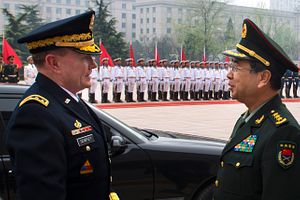Under Xi Jinping’s leadership, China has taken to calling for a new type of major power relationship with the United States. Yet, from America’s perspective, there have been few major breakthroughs in U.S.-China relations since Xi took the reins of the Communist Party in November 2012.
One notable exception to this has been military-to-military cooperation. The U.S. has long sought greater mil-to-mil cooperation with China on the belief that more frequent and frank exchanges would reduce distrust and the potential for conflict. For many years, however, there has only been very gradual progress on Sino-American mil-to-mil ties, and even this has usually been followed by a major setback over some intervening issue like U.S. arm sales to Taiwan.
Given this history, 2013 has been stunning with regard to U.S.-China mil-to-mil ties. The turning point seemed to come in April of this year, a month after Xi became president of China, when the new PLA Chief of Staff Gen. Fang Fenghui hosted his American counterpart, Martin Dempsey, in Beijing.
Since then there has been a seemingly never-ending number of senior military and defense officials traveling between Beijing and Washington for similar trips. In August of this year, for instance, China’s Defense Minister Chang Wanquan led a Chinese military delegation on a four-day trip to the U.S. The following month, Adm. Wu Shengli, the head of the PLA Navy, also traveled to the United States.
Meanwhile, Gens. Mark Welsh and Raymond Odierno, the chiefs of staff of the U.S. Air Force and Army respectively, traveled to China this fall. The two militaries also engaged in a limited joint military exercise around the same time, which will be followed by China participating in RIMPAC next year.
Besides going through the motions, Chinese leaders have also seemingly elevated the relative importance they place on mil-to-mil ties, at least rhetorically. When Gen. Dempsey was in Beijing back in April, Gen. Fang echoed President Xi in declaring that the PLA sought a “new kind of military relationship” with the U.S. During his U.S. visit in August, Defense Minister Chang also called for a new type of bilateral military relationship. The following month, Foreign Minister Wang Yi said military cooperation was a “bright spot” in U.S.-China relations.
I doubt Wang would make a similar statement today. Indeed, the past few months have seemingly proven right James Holmes and other skeptics of mil-to-mil ties. First, last month China announced it was creating an Air Defense Identification Zone in the East China Sea without any prior consultation or warning given to the U.S. America responded by defiantly flying two B-52 bombers in the area without complying with China’s new demands, and has refused to in any way alter its military operations in the newly formed ADIZ.
More tellingly, however, is the near collision between the USS Cowpens and a Chinese naval vessel in the South China Sea this month. Besides the incident occurring in the first place, the U.S. and China have spent the past week trading barbs over who is most at fault for the near collision. On Thursday, for instance, U.S. Defense Secretary Chuck Hagel said that the PLA Navy’s conduct had been “unhelpful” and “irresponsible.”
The entire incident is damning for proponents of mil-to-mil ties. One of their core arguments is that mil-to-mil ties will lead to greater communication and understanding, which will prevent incidents like the one in the South China Sea from happening. The unspoken assumption in this, of course, is that neither side has an interest in engaging in risky brinkmanship. If the U.S. side of the story is correct, and the PLA naval vessel cut off the USS Cowpens, then clearly this assumption isn’t always founded in the case of Chinese naval activities in its so-called near seas. Instead, China may believe that such brinksmanship could be very useful in advancing its goals, and — as James Holmes points out — this assessment might be completely accurate.
Sadly, U.S. officials appear disinclined to follow Holmes’ advice about acknowledging that the danger may not be one of miscalculation so much as it is China’s calculated policy moves. At his press conference on Thursday, Hagel followed his criticism of the PLA Navy by adding “We need to work toward putting in place some kind of a mechanism in the Asia Pacific and with China… Because as I’ve said… what we don’t want is some miscalculation here to occur.”
Again, the unspoken assumption is that both sides are “responsible” parties interested in avoiding “incendiary” incidents as Hagel referred to the Cowpens episode. Just moments before Hagel himself had more or less said that this is not the case with the PLA Navy.

































